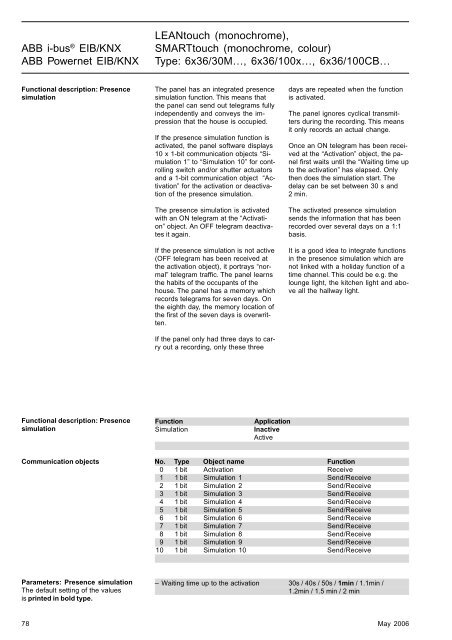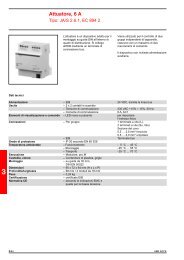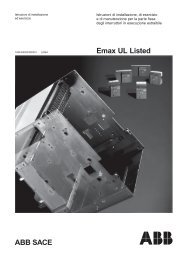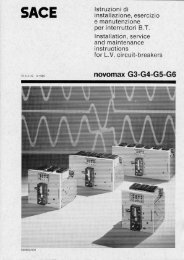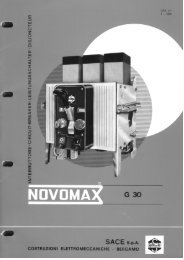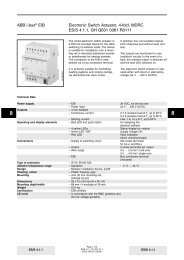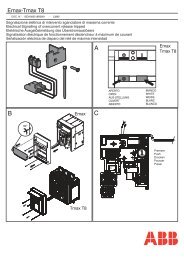ABB i-Bus® EIB/KNX ABB Powernet EIB/KNX
ABB i-Bus® EIB/KNX ABB Powernet EIB/KNX
ABB i-Bus® EIB/KNX ABB Powernet EIB/KNX
Create successful ePaper yourself
Turn your PDF publications into a flip-book with our unique Google optimized e-Paper software.
<strong>ABB</strong> i-bus ® <strong>EIB</strong>/<strong>KNX</strong><br />
<strong>ABB</strong> <strong>Powernet</strong> <strong>EIB</strong>/<strong>KNX</strong><br />
LEANtouch (monochrome),<br />
SMARTtouch (monochrome, colour)<br />
Type: 6x36/30M…, 6x36/100x…, 6x36/100CB…<br />
Functional description: Presence<br />
simulation<br />
The panel has an integrated presence<br />
simulation function. This means that<br />
the panel can send out telegrams fully<br />
independently and conveys the impression<br />
that the house is occupied.<br />
If the presence simulation function is<br />
activated, the panel software displays<br />
10 x 1-bit communication objects “Simulation<br />
1” to “Simulation 10” for controlling<br />
switch and/or shutter actuators<br />
and a 1-bit communication object “Activation”<br />
for the activation or deactivation<br />
of the presence simulation.<br />
The presence simulation is activated<br />
with an ON telegram at the “Activation”<br />
object. An OFF telegram deactivates<br />
it again.<br />
If the presence simulation is not active<br />
(OFF telegram has been received at<br />
the activation object), it portrays “normal”<br />
telegram traffic. The panel learns<br />
the habits of the occupants of the<br />
house. The panel has a memory which<br />
records telegrams for seven days. On<br />
the eighth day, the memory location of<br />
the first of the seven days is overwritten.<br />
If the panel only had three days to carry<br />
out a recording, only these three<br />
days are repeated when the function<br />
is activated.<br />
The panel ignores cyclical transmitters<br />
during the recording. This means<br />
it only records an actual change.<br />
Once an ON telegram has been received<br />
at the “Activation” object, the panel<br />
first waits until the “Waiting time up<br />
to the activation” has elapsed. Only<br />
then does the simulation start. The<br />
delay can be set between 30 s and<br />
2 min.<br />
The activated presence simulation<br />
sends the information that has been<br />
recorded over several days on a 1:1<br />
basis.<br />
It is a good idea to integrate functions<br />
in the presence simulation which are<br />
not linked with a holiday function of a<br />
time channel. This could be e.g. the<br />
lounge light, the kitchen light and above<br />
all the hallway light.<br />
Functional description: Presence<br />
simulation<br />
Function<br />
Simulation<br />
Application<br />
Inactive<br />
Active<br />
Communication objects No. Type Object name Function<br />
0 1 bit Activation Receive<br />
1 1 bit Simulation 1 Send/Receive<br />
2 1 bit Simulation 2 Send/Receive<br />
3 1 bit Simulation 3 Send/Receive<br />
4 1 bit Simulation 4 Send/Receive<br />
5 1 bit Simulation 5 Send/Receive<br />
6 1 bit Simulation 6 Send/Receive<br />
7 1 bit Simulation 7 Send/Receive<br />
8 1 bit Simulation 8 Send/Receive<br />
9 1 bit Simulation 9 Send/Receive<br />
10 1 bit Simulation 10 Send/Receive<br />
Parameters: Presence simulation<br />
The default setting of the values<br />
is printed in bold type.<br />
– Waiting time up to the activation 30s / 40s / 50s / 1min / 1.1min /<br />
1.2min / 1.5 min / 2 min<br />
78 May 2006


